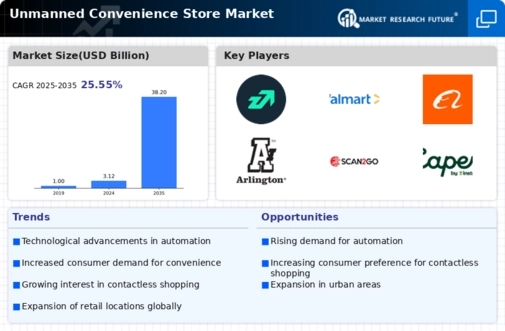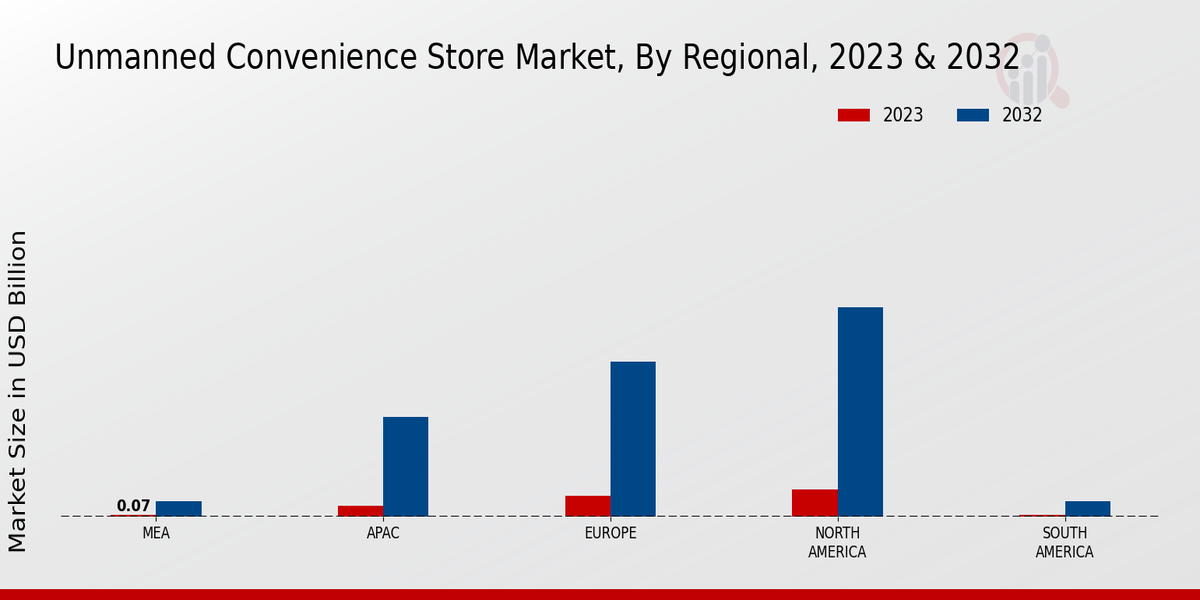Market Growth Projections
The Global Unmanned Convenience Store Market Industry is poised for remarkable growth, with projections indicating a rise from 3.12 USD Billion in 2024 to 38.2 USD Billion by 2035. This growth trajectory suggests a compound annual growth rate of 25.58% from 2025 to 2035, reflecting the increasing adoption of unmanned retail solutions. The market expansion is driven by various factors, including technological advancements, changing consumer preferences, and urbanization. As more retailers recognize the potential of unmanned stores to enhance operational efficiency and meet consumer demands, the industry is likely to witness a significant transformation in the retail landscape.
Technological Advancements
The Global Unmanned Convenience Store Market Industry is experiencing a surge in technological innovations, particularly in artificial intelligence and machine learning. These advancements facilitate seamless customer experiences through automated checkout systems and enhanced inventory management. For instance, companies are deploying smart cameras and sensors that track customer behavior and product movement, optimizing stock levels in real-time. This technological integration not only improves operational efficiency but also enhances customer satisfaction, as shoppers enjoy a quicker and more convenient shopping experience. The market is projected to reach 3.12 USD Billion in 2024, indicating a robust growth trajectory fueled by these innovations.
Changing Consumer Preferences
In the Global Unmanned Convenience Store Market Industry, there is a notable shift in consumer preferences towards convenience and efficiency. Modern consumers increasingly favor shopping experiences that minimize time and effort, leading to a growing acceptance of unmanned stores. This trend is particularly evident among younger demographics, who are more inclined to embrace technology-driven solutions. As a result, businesses are adapting their strategies to cater to these evolving preferences, offering 24/7 access and a diverse range of products. The anticipated growth from 3.12 USD Billion in 2024 to 38.2 USD Billion by 2035 underscores the importance of aligning with consumer demands in this dynamic market.
Cost Efficiency for Retailers
Cost efficiency is a pivotal driver in the Global Unmanned Convenience Store Market Industry, as retailers seek to reduce operational expenses. Unmanned stores require fewer staff members, leading to lower labor costs and enhanced profitability. Additionally, the automation of inventory management and checkout processes minimizes human error and streamlines operations. Retailers can allocate resources more effectively, focusing on strategic growth initiatives rather than day-to-day management. This financial advantage is particularly appealing in a competitive market landscape, where margins are often tight. As the industry evolves, the emphasis on cost efficiency is likely to attract more businesses to explore unmanned store models.
Integration of Payment Solutions
The integration of diverse payment solutions is transforming the Global Unmanned Convenience Store Market Industry. As consumers increasingly prefer cashless transactions, unmanned stores are adopting advanced payment technologies, including mobile wallets and contactless payments. This shift not only enhances the shopping experience but also aligns with the growing trend of digital payment adoption globally. Retailers are investing in secure and user-friendly payment systems to cater to tech-savvy consumers, ensuring a seamless checkout process. The ability to offer multiple payment options is likely to attract a broader customer base, further driving the growth of unmanned convenience stores in the coming years.
Urbanization and Population Growth
The Global Unmanned Convenience Store Market Industry is significantly influenced by urbanization and population growth. As urban areas expand, the demand for convenient shopping solutions increases, particularly in densely populated regions. Unmanned convenience stores are strategically positioned to cater to the needs of busy urban dwellers, providing quick access to essential goods without the constraints of traditional store hours. This trend is expected to drive market growth, as more consumers seek efficient shopping options in their fast-paced lives. The projected compound annual growth rate of 25.58% from 2025 to 2035 reflects the potential for substantial market expansion driven by urbanization.













